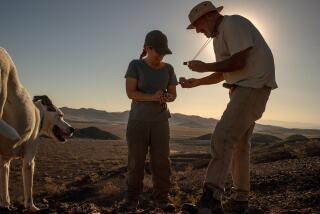150 to 200 Rings on Maryland Mountain : Circles of Stones Mystify Archeologists
- Share via
FLINTSTONE, Md. — They could have been cremation pits, cockfighting rings, animal pens, Civil War foxholes or secret hiding places for moonshine equipment.
Maybe they were prehistoric Indian burial sites, charcoal pits or foundations for dwellings. Or maybe, some say, the stone circles dotting the western slope of Polish Mountain encircled apple trees in the early 1900s.
For more than a decade, 150 to 200 circles of sandstone rock have puzzled area residents and archeologists. Virtually hidden by brush and poison ivy, the gray-colored rocks of various shapes and sizes are neatly arranged in circles.
No one knows their purpose, or who put them there.
“Everybody that goes up there has some kind of weird theory,” said John Mash, manager of Green Ridge State Forest, where the circles are found. “One guy even mentioned that they could have been sweat lodges--like a Turkish bath.
‘Something Like a Sauna’
“The Indians would have these rituals when they would go into manhood,” he said. “They would go in these buildings with hot rocks and put water on them--something like a sauna.”
But 150 to 200 saunas on one hillside in western Maryland?
Mash said rangers noticed the stone rings in the early 1970s. In 1975, Mash contacted State Archeologist Tyler J. Bastian, who visited the site and put the circles on a list of archeological areas in Maryland.
But it was not until last year that some archeologists and volunteers excavated one of the circles. “They did the dig and found zip, except for the rattlesnakes,” Mash said.
Hoping to uncover clues, another group conducted a dig this spring.
“In a nutshell, we didn’t discover anything. They still remain a mystery,” said Charles McVeigh Jr., a member of the Western Maryland Archaeological Society. “We dug out in the center of them. We didn’t go down very far before we got to bedrock. We found no artifacts. We found nothing to indicate prehistoric use.”
Two Archeologists Moved
No future digs are planned, and two local archeologists who took an interest in the circles, Robert D. Wall and Connie Huddleston, both have moved from Maryland. Neither could be reached for comment recently.
Meanwhile, the state forest has put the circles on its historic preservation list to ensure that the five-acre tract remains untouched, Mash said. The site could be eligible for the National Register of Historic Places if additional information could be found to document the age of the rings, their use and significance.
Mash has dismissed the moonshine theory because there is no nearby water source needed to make moonshine. He said he did not think they were cockfighting rings because only one pit is needed to hold a fight. And the rings are too close together to have been foxholes during the Civil War, he said.
“The site has no strategic value,” Mash said. “(And) the guy in the middle foxhole is going to be shooting his own pals before he can get his bullet out to hit the bad guys.”
Apple Orchard Theory
Until someone conjures up a more believable theory, Mash said he puts the most stock in the orchard theory--that someone placed the stones around apple trees that once grew in the area. There were 1 million apple trees in Green Ridge by 1914, he said.
“It is possible that they hired immigrants who could not understand directions given in English and some of them were told to clear the rocks away to plant the apple trees,” he suggested.
“They were new in America and wanted to do a nice, neat job, so they put these rocks in nice neat little circles and left a space in the middle for the tree. And they might have worked on these for a couple of days, or a week until somebody stopped them. That could be a theory. . . .”
More to Read
Sign up for Essential California
The most important California stories and recommendations in your inbox every morning.
You may occasionally receive promotional content from the Los Angeles Times.













